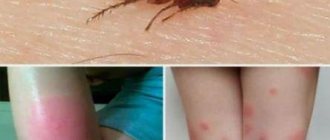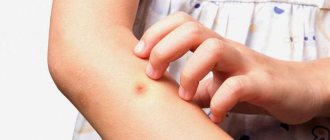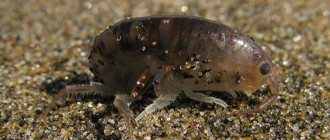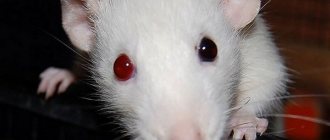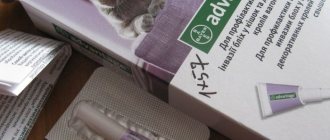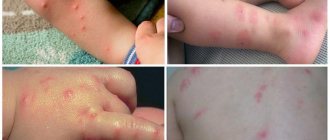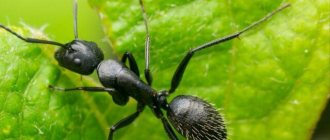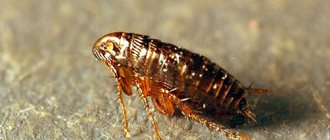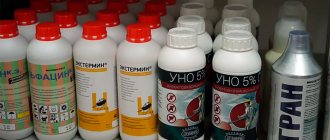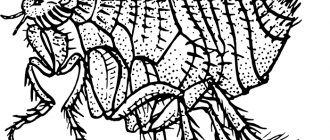How to treat flea bites on a person if, in addition to itching and inflammation, an allergic reaction begins or an infection develops? Fleas are not gourmets and feed on the blood of animals, even if they are sick, and the saliva of parasites contains strong allergens. For example, the rat flea transmits various diseases from rodents to humans. It was because of them that a plague pandemic began in the 14th century, which claimed the lives of 60 million, a quarter of the entire population of the planet.
Fleas that pose a danger to humans
Among obligate parasites, the main feature of which is that their entire physiology is configured to feed exclusively on blood, fleas occupy an important place. Typically, these insects parasitize warm-blooded animals such as dogs, cats, birds, rats, pigs, horses, cows and others. But this does not mean that they do not threaten a person, it is just that he is rarely the main host, more often a temporary one, intended solely for maintaining life or transferring if there is no other object more suitable for this purpose nearby. Human body temperature, lower than that of animals, poor hair, good hygiene - all these conditions make people unsuitable for fleas.
It should be noted that there are exceptions to this rule, which include the so-called human flea, whose oral apparatus is optimally prepared for piercing the skin of people, and the characteristics of its life activity are closely related to human housing. Although some small animals such as dogs and cats can also become victims of this insect.
Of the more than 2,000 varieties of fleas, almost all can bite a person, but you should consider those that account for the bulk of the bites.
The bulk of bites occur:
Dog fleas
It is this type of flea that bites people more often than others. This situation can be explained by the large number of these parasites, which can live even on one pet. In addition, dogs are constantly on the street, where they come into contact with possible sources of infection.
Cat fleas
The prevalence of fleas of this species in the world is significant; they can feed on many species of mammals. They move to people for the purpose of feeding due to the fact that there are usually not many of their original owners, cats, in the house.
Rat fleas
In modern cities, they rarely parasitize humans, but for rural areas and the private sector, the problem of bites by this type of insect remains relevant. In addition, it is rat fleas that usually carry the most terrible diseases, so they pose the greatest infectious danger.
Rabbit fleas
This type of parasite rarely affects people, but compared to the remaining unlisted insects, the percentage of their bites is the highest.
It should be understood that all other types of fleas, which traditionally parasitize other animals or birds, can bite through human skin and begin to feed on his blood, so there are no fleas that are safe for people.
What is each of the listed types?
Let's start with the human flea, since for it people are the main source of food.
Externally, this type of parasite differs little from its relatives. They are distinguished by their larger size, which sometimes reaches 4 mm. Such a large individual can jump half a meter in length. The body of the parasite is flattened to the sides; antennae and piercing-sucking mouthparts are located on the small head. Due to the small size of the “mouth,” the flea is not always able to reach the blood vessel directly, so at the moment of the bite it is forced to immerse the entire head and front part of the body into the skin of the victim, making its way as deep as possible. At this moment, her body is almost vertical. The picture is completed by 6 legs, of which the hind ones are designed to make leaps tens of times greater than the size of the insect itself. The flea's jump is so rapid that the human eye is unable to discern it, so all that is visible is how the parasite disappears.
The structural features allow these insects not to be afraid of damage when a person catches them or scratches the bite sites; the dense upper shell protects the individual from being crushed.
The structure of their paws and antennae helps them stay on the host, although these insects do not live on it permanently. Adults spend most of their existence in secluded places located near permanent human habitation. When hungry, they lie in wait for people or animals passing by and jump on them, then, after piercing the skin, suck blood. Having had enough, the parasites try to leave the host’s body. Interestingly, this parasite can exist without food for about one and a half years.
The female lays several eggs at a time, but they do not attach to the hair or skin, but fall down, filling floor and wall cracks, carpet and furniture pile, and animal bedding. Here the larvae develop in organic debris. They feed on the excrement of adults or rotting organic matter. Their length does not exceed a few millimeters, the body is worm-shaped and white in color. After a few weeks, the larva turns into an adult insect, but only if there is a food source nearby, otherwise it can remain in the cocoon until the opportune moment.
Adult fleas live for several months, during which time they can lay about five thousand larvae.
Cat, rat and dog fleas are similar in physiological structure to each other and to the human species. The difference is related to color and size, but they are so insignificant that only a specialist can recognize them using equipment.
Clinical researches
Based on the results of numerous clinical studies, La-Cri products, including cream for sensitive skin, are recommended by the St. Petersburg branch of the Union of Pediatricians of Russia.
The effectiveness, safety and tolerability of the products have been proven by a clinical study. The cream is also suitable for daily skin care of children with mild to moderate forms of atopic dermatitis and during remission, accompanied by a decrease in the quality of life of patients. As a result of therapy, a decrease in the activity of the inflammatory process, a decrease in dryness, itching and flaking was noted.
It has been clinically proven that La-Cri cream for sensitive skin:
- reduces itching and irritation;
- relieves skin redness;
- moisturizes and gently cares for the skin.
Sources:
- Kovyazina N.A., Fedosimova N.A., Illek Ya. Yu. Diagnosis of atopic dermatitis in young children, Vyatka Medical Bulletin, 2007
- Smirnova G.I. Managing the course of the disease: atopic dermatitis in children, Russian pediatric journal, 2014
- N.L. Rybkina, Modern approaches to newborn skin care: pediatrician tactics, journal Bulletin of Modern Clinical Medicine, 2014
- I.I. Ryumina, V.V. Zubkov, Newborn skin care, Healthy Child magazine, 2017
Features and danger of flea bites
When a flea pierces the skin and begins to drink blood, a person experiences a strong painful sensation comparable to a needle prick. This effect can be explained by the fact that this parasite, unlike bedbugs and ticks, does not inject natural painkillers into the wound when it bites.
Many of the consequences of flea bites depend on the action of toxic enzymes that the flea injects along with saliva into the bite to prevent blood clotting. Thanks to these substances, blood begins to flow into the insect’s stomach in a thin stream almost independently.
When the flea detaches itself from the bite, the elastic walls of the skin will close and prevent bleeding from escaping, but it can continue under the dermis and lead to the formation of a small hemorrhage. If the concentration of bites in one place is high enough, the bleeding may turn into purpura, which is dangerous in its consequences.
A painful bite is the least of the evils that a flea can cause.
Consequences of a flea bite:
- Severe allergy to an enzyme that prevents blood from clotting. It can range from itching, redness, rashes to swelling and anaphylactic shock.
- The flea itself can serve as a carrier of a huge number of serious diseases.
- By scratching the bite site, a person can infect the wound.
The allergy is usually caused by flea saliva enriched with an enzyme. An allergic reaction occurs in people suffering from hypersensitivity to insect bites in general and flea bites in particular. Children under 12 years of age are most susceptible to it.
Diseases whose pathogens are transmitted by parasites themselves pose a huge danger. Their specificity is largely determined by the type of blood-sucking insect.
Earth flea bite
The bite of an earthen flea, which is also called a sand or sea flea, has its own characteristics. These parasites, living in the habitats of birds and rodents, not only bite through the skin and drink blood, increasing the above risks, they make their way into the skin under the nails, laying eggs there. As a result of such actions, the bite site becomes severely suppurated. The larvae grow in this environment, feeding on the resulting pus and surrounding tissue. Itching, swelling, and irritation appear at the site of the lesion. Doctors diagnose sarcopsillosis.
Cat flea bite
Parasites of this species cause many infectious diseases in humans, including even plague, as well as fungal viruses. They can be carriers of cucumber tapeworm eggs, a special type of parasitic flatworm that reaches a length of 50 cm, and other helminth diseases, such as toxocariasis. Helminth eggs enter the flea's digestive tract along with the blood during bites. When a parasite injures a person, they enter his body and the hatched larvae are carried by blood throughout the human body, along the way affecting the lungs, liver and other organs with allergic inflammation.
Rat flea bite
A rat flea bite can have the most serious consequences. This type of parasite spreads plague, endemic typhus and a number of other diseases.
Among the agents carried by fleas that pose the greatest danger are the causative agents of tularemia, typhus, salmonella, encephalitis virus, trypanosomes, as well as anthrax spores. In total, about 200 representatives of life-threatening diseases were identified on representatives of various subspecies of these parasites. Therefore, you can never predict what the next flea bite will turn out to be. Microbes in the body of this insect can exist for more than a year, significantly increasing the number of infected people.
It is important to refrain from scratching the wound, since the canal formed as a result of flea feeding can receive excrement of the parasite and various types of infections left on the victim’s skin, which greatly increases the risk of re-infection. In disturbed wounds, pus may begin to accumulate, which will cause more trouble than the initial bite. The damaged area should be properly treated to reduce itching and the risk of infection.
Different types of insects and the damage they cause
Sand (ground) fleas are very dangerous to human health. Bites cause purulent abscesses because the insects penetrate the skin and multiply there. This can lead to the development of serious diseases. Prevention includes wearing socks and shoes, keeping your home clean, and washing your feet after walking in contaminated areas. These measures will help avoid infection from sand flea bites. Treatment is possible in a surgical setting: the flea is removed with tweezers, the wound is disinfected and a bandage is applied.
Pets are also susceptible to attacks by these insects. Both cats and dogs can have fleas. An animal that is affected by these parasites shows anxiety, bites itself, scratches itself, trying to catch the flea with its teeth. Dog (cat) flea bites cause allergic dermatitis in animals.
Flea bite symptoms
A flea bite looks like a slight redness with a pink halo. The enzyme from the parasite's saliva gets under the skin and an allergic reaction occurs, manifested by itching and red dots. If a human flea has bitten, the redness may be larger, resembling a cigarette burn.
In most cases, a blister is observed within the first few hours after the bite, which resolves quite quickly. But marks at the wound site can persist for up to several days due to microhemorrhage remaining under the skin. The duration and severity of the consequences depends on the individual reaction of a particular organism.
As for the location of bites, they are usually located on the feet and legs, although sometimes they can occupy other open areas of the body. If parasites attack a sleeping person, they can bite the neck, armpits and arms. Fleas tend to pierce the skin in several places in a certain sequence at a distance of one or two centimeters from each other, but without forming paths characteristic of bedbugs.
Let's summarize the signs of flea bites:
- Stitching sharp pain at the moment of the bite.
- Itching from a flea bite, more pronounced than from a mosquito bite.
- Formation of small tumors.
- The location of the bites is on the legs and occasionally in other places.
- A series of bites characteristic of these parasites.
If the listed symptoms are well expressed, supplemented by profuse rashes in the area of the bites, their suppuration, ulcers in the mouth and throat, enlarged lymph nodes, fever and headache, insomnia, we can talk about the presence of a disease such as pulicosis, which is understood as a dermatological disease caused exclusively flea bites. This disease is usually caused by human fleas.
Allergy to flea bites
We can talk about allergies if these symptoms are accompanied by a body temperature reaching 40C, anxiety, difficulty breathing, diarrhea and a feverish state. If the patient has a history of hypersensitivity, the situation may be complicated by anaphylactic shock. All descriptions given indicate the need to immediately contact qualified specialists.
Characteristic symptoms
The bitten area swells and is very itchy and itchy. The wound heals within 3-4 days. She will continue to itch until it heals. Adults are most often bitten on the legs and feet. On other parts of the body, bites are possible, but are rare. If insects attack during sleep, the neck, arms and armpits will be bitten. One insect tries to bite the victim several times. The distance between bites varies from 1 to 2 cm. Enlarged lymph nodes, increased body temperature, and development of urticaria are possible.
In rare cases, angioedema and anaphylactic shock develop. It is necessary to provide first aid to the patient as quickly as possible. Otherwise, death is possible.
How to treat flea bites?
First aid measures for flea bites should be aimed at disinfecting the wound and relieving itching, which can provoke a subsequent increase in the affected area. Here are some possible options for this procedure:
- The bite site is wiped with warm water and an antiseptic soap solution.
- If the damage was severe, you can blot it with a cotton swab with a solution of apple cider vinegar in a 1:1 ratio or a mixture of water and citric acid. It is recommended to treat bites in this way several times a day, especially if scratching has already formed at the site of the lesion, which will quickly heal from such a measure.
- For disinfection, it can be helpful to treat bites with antiseptic gels and liquids, such as boro-plus and calamine lotion.
- Hydrocortisone, flucinar or similar steroid ointments will help cope with severe itching and alleviate pain. It is advisable to discuss the use of these medications with your doctor.
- Rubbing with ice cubes wrapped in gauze will relieve itching, reduce inflammation and prevent swelling.
- To stop the bite from itching, it is treated with a weak solution of baking soda (a teaspoon of soda per 200 ml of boiled water), which cleans the wounds well when used several times a day.
- In this case, traditional medicine recommends using plantain juice or plants such as parsley, dandelion, celandine, calendula or garlic gruel. Lotions are made from a strong decoction of green tea.
- To combat inflammation, you can resort to sulfur ointment.
- Antihistamines can neutralize the unpleasant symptoms that appear after flea bites, but before taking them, you should consult with your doctor.
- Pharmacy creams that say “after insect bites” are effective.
It is better to perform the above actions in a certain sequence to increase their benefits.
Here is an example algorithm:
- The bite is treated with antiseptics (cleansers, alcohol lotions, soap).
- The injury site is cooled with ice or a cold compress.
- Anti-itching agents (ointments for insect bites, soda solutions) are applied to the affected areas.
Usually these measures are enough to ensure that the bite goes away without consequences and quickly stops bothering you. But there are times when it is necessary to immediately seek help from doctors: an extreme situation is indicated by symptoms of severe intoxication, repeated infection or a pronounced allergic reaction. They are indicated by headache, hives, lethargy, high fever and suppuration of wounds.
Itching relievers
Products for relieving the sensation of itching, which only intensifies after scratching, are produced in the following format:
- ointments;
- sprays;
- emulsions;
- suspensions;
- tablets;
- lotions.
The following pharmacological compounds have proven their effectiveness:
- Calamine. The product is in the form of a white lotion based on zinc carbonate. Instantly relieves itching (the product is even used to relieve itching sensations during chickenpox), removes tissue swelling and promotes wound healing. The bite sites are treated with a cotton pad or swab dipped in the substance three times a day until the redness completely disappears. It has no contraindications and is used for adults and children.
- Fenistil. Local action gel relieves itching, burning and pain. Apply to the affected area 3-4 times a day. It is available in a convenient tube format, but has a number of contraindications. Not recommended for use on children, pregnant and lactating women.
- Flucinar. Hormonal ointment, which is recommended to be rubbed into the wound with massage movements twice a day. It has contraindications for use; it should be used only as prescribed by a doctor and no more than 2 g per day.
- Hydrocortisone. A glucocorticosteroid drug based on hormonal components. Available by prescription in 10 g tubes, used only for external use.
- Antihistamine tablets: Suprastin, Claritin, Loratadine, Diphenhydramine. Relieves allergy symptoms and is easy to use. However, the effect of relieving itching is not achieved immediately, but 20–30 minutes after taking the medicine. Tablets also do not protect the wound from inflammation.
Flea removal
No means will protect against the bites of these insects unless measures are taken to completely remove fleas and prevent their reappearance. For this purpose, it is necessary to identify the source of infection. Pets will be first in line and need to be thoroughly examined for parasites. Fleas will reveal themselves not only by their personal presence, but also by particles of dark brown excrement on the animal’s skin.
To remove them, pets are washed with special shampoos or treated with insecticides in the form of sprays and gels. It is important to remember that parasites can be found not only on the animal’s body, but also infest pets’ favorite resting places - bedding, surfaces of floor carpets and sofa bedspreads, which must also be thoroughly cleaned.
The entire living space should be vacuumed, paying special attention to corners and crevices, and all surfaces should be treated with disinfectants. It is advisable to destroy the garbage bag from the vacuum cleaner immediately, since it contains fleas and eggs collected during cleaning. Given the duration of the transformation of the larva into an adult parasite, disinfection should be repeated after two weeks to destroy mature fleas. Each room must be treated in the most thorough manner, and a car is no exception if a pet was transported in it.
Protection from insect bites during disinfestation will be provided by pharmaceutical products designed to protect against blood-sucking insects.
To carry out disinfection, it is recommended to use insecticides such as solfak, chlorpyrimark, tetrix, and ultra effectively.
Before using them, remove any heat sources that may cause a fire if they come into contact with chemicals. Animals must be taken out of the premises and food must be hidden so that toxic components do not come into contact with them. After disinfection, the remaining drugs must be washed off, as they pose a danger to people and animals.
You cannot destroy parasites with chemicals that are not intended for this purpose. Incorrectly selected components can lead to mutation of fleas, which will greatly complicate their subsequent removal. In this case, you will have to seek help from specialists who are engaged in the destruction of parasites.
For preventive purposes, you can spread dry or fresh wormwood around the house, taken together with the inflorescences. It is recommended to place it on baseboards, under carpets and other areas where these insects are most likely to appear. This measure can also be effective against existing parasites. Tansy tincture has a similar effect, which is recommended to periodically spray the premises.
Proven repellents
Treating bites is a troublesome and time-consuming task, so it is better to prevent flea attacks with the help of repellent substances. Repellents are recommended for use by people at high risk of flea bites:
- pet owners;
- those who work in conditions of high humidity and dampness;
- those who are often on the street, as well as near untrustworthy contaminated premises and territories.
Effective products that repel fleas from humans:
- Spray OFF Smooth & Dry. Available in the form of a “dry aerosol”, it acts on the skin and clothing for 3–4 hours, and can be used no more than 2 times a day. Before going to bed, wash off the substance with warm soapy water.
- Mosquitoll. The spray has a persistent lemon scent and does not leave greasy stains on skin or clothes. One-time treatment within 24 hours is possible. Use is contraindicated to protect children and pregnant women.
- Medilis comfort. A spray that is sprayed not on the skin, but on clothes, tents, and mosquito nets. Provides protection against blood-sucking insects for 20 days after application.
A flea bite is always an unpleasant surprise, and you need to react to it immediately. Timely treatment using pharmaceutical products or folk remedies reduces the risk of complications and makes a person feel better.
Destruction of fleas in Pokrov
Finding these parasites is not difficult. But after you already know that they live with you, the question arises - “what to do next?” First of all, examine the pets and carry out a special treatment with insecticidal drops, lotions or sprays; you can wash the animal with a special shampoo. There are many different products that can be purchased at a veterinary store.
At the same time, you need to destroy fleas in the apartment itself. They, like many parasites, can hide in various crevices, furniture that has pile, carpets, etc. Fleas will not live long in an open environment because they need regular food. But if you ignore the “cleaning” of the apartment, you can give your pet a chance to become infected again.
There is the following sequence of actions after detecting parasites in an apartment:
- Carry out a wet general cleaning of the apartment;
- Wash everything possible (clothes, curtains, carpets, etc.)
- Treating all cracks, walls, furniture with a special product;
- Ventilate the room well.
But you need to know that complete treatment and cleaning does not protect you from the return of parasites. Especially if your pet loves to go outside. In this case, it is recommended to purchase a special collar - it has the property of repelling these parasites. Or you can use special drops (for example, Bars). Also, do not allow such pets into your bed.
In case of severe infection of the apartment, it is best to call the SES service. The sanitary and epidemiological station will destroy fleas much faster and you won’t have to rack your brains. SES employees offer comprehensive services for the destruction of parasites. You can call the housing maintenance office (ZhEK) to call the SES in Pokrov.
Treatment methods for bites
If you are bitten by a cat or dog flea, the wound can be treated with any antiseptic (for example, hydrogen peroxide).
If the bite is very itchy, then you need to treat the surface of the skin at the site of the bite with a soothing antihistamine gel and take 1 tablet of Suprastin. Don’t immediately panic and call an ambulance. Medical attention is only needed if a severe allergic reaction develops.
You can also use folk remedies; for disinfection, you can use tea tree oil or a compress of potato juice.
